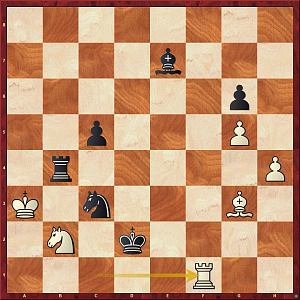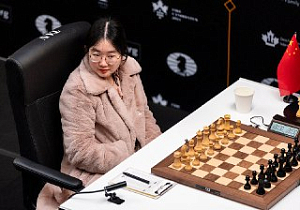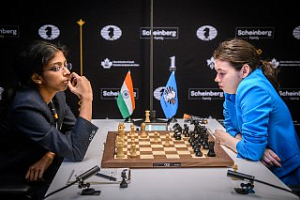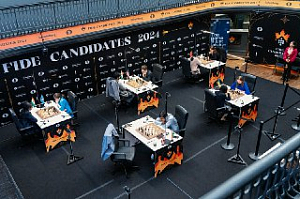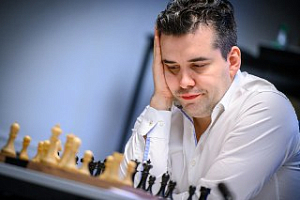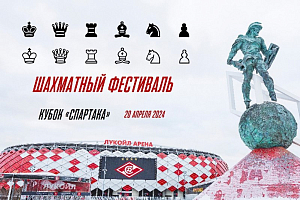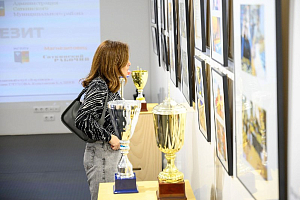9 May 2016
The Russian Club Championship: Forty Years of History
Dmitry Kryakvin's blog about the first five days of the Russian Club Championship.
Day five
The first surprise came up in the Premier League: Zhiguli prevented the leaders from Moscow from scoring the full two team points, and the Siberians caught up with the leading team at the half-way stage of the event. And to think that the start was so smooth for Sergey Smagin and Alexander Zlochevskij's team! Less than an hour of playing time elapsed before Ian Nepomniachtchi and Daniil Dubov popped out onto the red path linking the elite teams' area and the main hall. The young men's faces shone with sincere happiness, and everyone around immediately understood that something very, very significant had happened. And it had! Nepomniachtchi, with his friend's help, was able to dispel an opening myth that had remained alive since 1979!
Nepomniachtchi – Sjugirov. An opening bomb will soon explode
Nepomniachtchi (ShSM Legacy Square Capital) – Sjugirov (Zhiguli)
1.e4 e5 2.Nf3 Nf6 3.Nxe5 d6 4.Nf3 Nxe4 5.c4 Be7
It's probably a little early to describe the move 5. c4 as a refutation of the Petroff Defence - there are alternatives like 5...Nc6 and 5...c6, but it's perfectly possible our creative duo had prepared some unpleasantness for Black there as well.
6.d4 0–0 7.Bd3 Ng5
Black's main idea in this line, and one given the stamp of approval all the way back in 1979 by young Petroff specialist Sergei Makarychev. It remained the basic idea for a long time... until 2016, it turns out! Black intends to exchange off a pair of minor pieces.
8.Nc3!
In the 90s White tried to get an advantage after 8.Nxg5 Bxg5 9.Qh5 Re8+ 10.Kd1 h6 11.Bxg5 Qxg5 12.Qxg5 hxg5 13.Nc3 Bd7!, but on three occasions Vladimir Akopian managed to hold with Black at a high level, after which the popularity of 5. c4 sank dramatically. Ian follows the game of the pioneers of this line.
8...Bg4?
This is what happened in that epic USSR Championship in the encounter between two-time USSR Champion Vitaly Tseshkovsky and Sergei Makarychev. Black's move looks very logical, but, trusting in his classical predecessors, Sanan fell into a trap. It's interesting that in 1994 Petroff expert Eduardas Rozentalis prefered: 8...Nxf3+ 9.Qxf3 Nc6 10.Be3 Bf6, which didn't, however, equalize - White has a powerful initiative with a mass of minor pieces remaining on the board. Did Rozentalis really find the h7-blow at the board and avoid the temptation?
8...Nc6 was chosen by Sergei Azarov a couple of years ago, but that's no fun! The endgame after 9.Nxg5 Bxg5 10.Qh5 Re8+ 11.Kd1 h6 12.Bxg5 Qxg5 13.Qxg5 hxg5 14.Nd5 is clearly better for White.
9.Bxg5
9.Be2? Even as strong a tactician as Tseshkovsky chose this simple move, and after 9...Nxf3+ 10.Bxf3 Bxf3 11.Qxf3 Nc6 12.Be3 Bg5 Makarychev got a comfortable position. But honestly, who could have expected that despite not yet castling White is ready to unleash such an exquisite tactic?
9...Bxg5
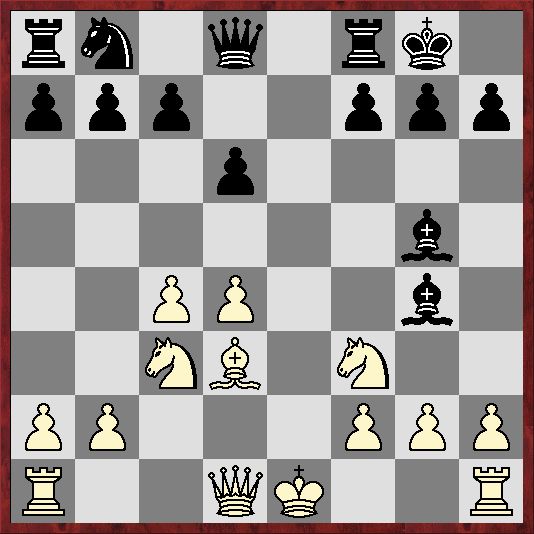
10.Bxh7+! Kxh7 11.h4!! Bd2+
Simply amazing! Black doesn't have much choice, since 11...Bxh4 12.Qd3+ Kg8 13.Rxh4 loses, while 11...Re8+ 12.Kf1 Bh6 13.Ng5+ Qxg5 14.hxg5 Bxd1 15.Rxd1 Nd7 16.gxh6 gxh6 leads to a sad ending with a weakness on h6 that White can soon attack with his rooks. The b5 and d5-squares are also lying in wait for the white knight.
12.Qxd2 Re8+ 13.Kf1 Bxf3 14.Qd3+! Kg8 15.Qxf3, and Nepomniachtchi went on to convert this extra pawn.
Bravo, Daniil! Great job, Ian! And Sanan has no reason to be upset, since at that moment Zhiguli lined up behind their fallen captain and dashed out of their trenches to start a bayonet assault against the leaders.
The winner thaned Daniil Dubov on Twitter right after the end of the game
In fact, after taking the lead and seeing such beauty on the first board, ShSM played in a somewhat relaxed manner: for instance, Vladimir Malakhov, having his trademark position with an edge, allowed Yuri Yakovich to secure an easy draw. Meanwhile, Igor Lysyj converted to a better rook endgame versus Evgeniy Najer, which was extremely dangerous for the Muscovites. With the technique of the Russia 2014 champion, one could only smile at Savielly Tartakower's statement about all rook endgames being drawn.
Lysyj (Zhiguli) – Najer (ShSM Legacy Square Capital)
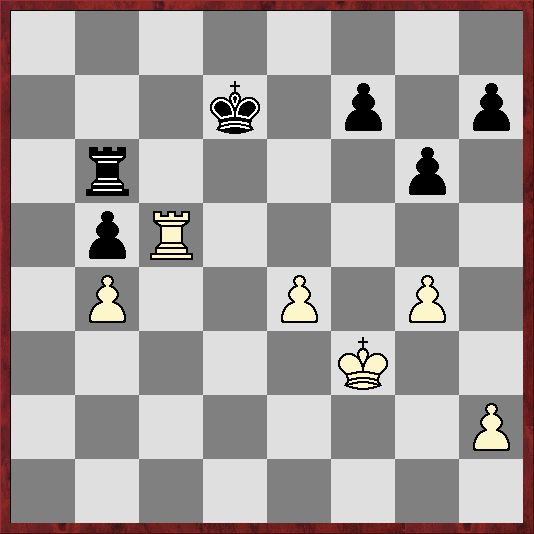
Black's rook has stayed idle for too long, and Najer should have set it at large right away: 45...Rf6+, abandoning the b5 pawn and counterattacking White's pawn weaknesses before Lysyj's pieces were brought to some harmony and the passed pawn went too far. Najer decided to postpone this important decision by a move, but it went rather badly, weakening his kingside.
45...f6? 46.h4! Ra6
46...h6 47.h5 is no good: this pawn will become a queen when White's king slips through to g6.
47.g5 Ra3+
For better or worse, Black should have opted for 47...fxg5 48.hxg5 Ra1 49.Rxb5: although the fighter on g5 locks up two opponents, White has two healthy passers... Impulsive checks enabled Igor to remove everything from the board easily.
48.Kf4 Rh3 49.gxf6 Rxh4+ 50.Ke5 Rh5+ 51.Kd4 g5 52.Rxb5 Ke6 53.Rb6+ Kf7 54.e5 Black resigned.
The match's last intrigue was the Geller vs. Popov encounter, where Ivan had to defend a position with a knight, a bishop, a pawn on the queenside and two pawns on the kingside versus a rook, two pawns on the queenside and three pawns on the kingside. Emanuel Lasker once received a special award, Defense of the Year, for saving such an ending; you can study this endgame in excellent books by Mihail Shereshevsky whom I had the honor to meet at the Russia 2016 Children's Championship in Loo. A hundred years passed since Lasker's time, defensive techniques improved, Mark Dvoretsky and his alumni appeared. Popov reached the safe haven fairly quickly. 3-3!
The first half is over, and the most interesting developments are only about to start. Our hearts are beating impatiently for the Kramnik vs. Karjakin game to begin!
Day four
A short lyric digression before I add another note to the blog. You've probably visited the section "Person of the Day" on our website. The Persons of the Day and Positions of the Day format was invented by Mark Gluhovsky. As far as I know, a couple of decades ago, when the KasparovChess website was launched and a team of chess players and journalists was brought together there, Mark actually developed and introduced this very idea. Over the past year, Vladimir Barskij and I have been working on giving a major boost to that section. It's not an encyclopedia yet, but much has been done already.
So now it's impossible to ignore Chinese chess and Chinese Persons, who include world and Olympic champions as well as the chess queen Hou Yifan and her teammates. Which is why I had to conduct an in-depth study of the East when working on the section. The East is a delicate matter, but there's the Google Translator, which is getting better every moment. Just like Wei Yi. It even translates texts with Chinese characters. The style is a disaster, but one can understand the sense. And so I started to get to know China – little by little, remotely, interviewing grandmasters and experts along the way.
It turned out that the Chinese are a very sophisticated nation! There's no point arguing or bargaining with them. I'll give you two fresh examples. Before the Mariya Muzychuk vs. Hou Yifan match, the Chinese Chess Federation exerted tremendous pressure on the host party and accused the Ukrainians that, instead of preparing for the match, they only thought about how to communicate the moves from Stockfish's first line to Mariya. The Chinese demanded online delays, security measures and commission meetings, threatening to complain to FIDE at every trifle. Later the organizers of the Ukrainian championship were reproached of not broadcasting Muzychuk's games. But this was a defensive response: well, you have spy mania, and so do we.
Example two: the famous China-Russia Challenge Match, with teams of five, which ended by Sergey Karjakin's single-handed victory. As is well-known, the Russian team led by the Moscow grandmaster led 4:0 after the first half of the event, and Sergey arrived for the second half together with Dmitry Andreikin and Ian Nepomniachtchi, Russian players No. 4 and No. 5 on the list. Meanwhile, Evgeny Tomashevsky and Alexander Morozevich didn't come for the second part as they had been attending the first one. And then the Chinese said: "So your No. 2 and 3 are not here; if Karjakin gets knocked out, we will give them zeros and insist that those games are counted!" A scandal was about to break out, but then Karjakin said: "Don't worry, guys, everything will be OK, I'll knock out the fifth Chinese, and there'll be no scandal". And he was as good as his word.
Why am I writing all this? Before the Russian team championship started, it became known that Li Chao wouldn't play for Siberia: he had been invited to Stavanger. Another Chinese, Bu Xiangzhi, was on the St. Petersburg team, but your author came across him on the very first day on an embankment in the company of Lu Shanglei, the rising star of Chinese chess, who wasn't listed in any team. What is Lu doing in Sochi? The managers of the Medny Vsadnik (The Bronze Horseman) team just brushed the matter off: why, Bu just brought his friend and second to Sochi, they will go to a tournament together later. But some well-informed people explained: the Olympiad will soon start in Baku, where the Russian and Chinese teams, together with the Americans, will be the main favorites to win. And all the novelties prepared by the Chinese during their last training session are on Bu's computer. What if Russian geeks hack his electronic assistant while he is playing?
As a result, it was quite amusing to watch Bu's friend. As soon as Lu Shanglei got his older colleague to sit down and start playing another game, he rushed off to his room in all haste. Apparently to guard the precious laptop.
Dmitry Jakovenko vs. Bu Xiangzhi
In the fourth round, Bu Xiangzhi participated a crucial match that would decide who would pursue the Muscovites in the tournament table: Bronze Horseman, with the Chinese onboard, encountered Siberia. There were equal, tenacious combats on most of the boards, including in the Jakovenko vs. Bu Xiangzhi game, which ended in a draw, but the match was decided in the Siberians' favor unexpectedly easily. Sergei Rublevsky wove a mating net around Maxim Rodshtein's king in a very entertaining position with opposite-colored bishops, while on the first board Vladimir Kramnik defeated Peter Svidler in a pivotal encounter.
Faces full of determination
Svidler (Bronze Horseman) – Kramnik (Siberia)
1.c4 e6 2.Nc3 d5 3.d4 Nf6 4.cxd5 Nxd5
The Improved Tarrasch Defense is Kramnik's draw-forcing nail in the coffin of the move 1.d2-d4. Which is why modern players have to switch to Nf3, e3...
5.Nf3 c5 6.g3!?
Instead of the much-used 6.e4 Nxc3 7.bxc3 cxd4 8.cxd4 Bb4+. An old recipe by Akiba Rubinstein and Alexander Alekhine, which has now regained popularity.
6...Nxc3
White's idea is to get a better endgame after 6...cxd4 7.Nxd5 Qxd5 8.Qxd4 Qxd4 9.Nxd4 Bb4+ (9...Bc5 10.Be3 Bacrot – Wang Hao, 2014) 10.Bd2 Bxd2+ 11.Kxd2 Ke7 12.Bg2 Rd8 13.Ke3 Na6 14.Rac1, – in the 1937 rematch, Alekhine won here an important and instructive game versus Max Euwe. The belligerent 6...Nc6 is possible, which recently happened in a Karjakin vs. Caruana game in Khanty-Mansiysk – in that very game where the arbiter had trouble counting to three. But Kramnik chose the most solid response.
7.bxc3 cxd4 8.cxd4 Bb4+ 9.Bd2 Bxd2+ 10.Qxd2 b6
About four years ago, Denis Khismatullin defended 10...Bd7 successfully, for instance, 11.Ne5 Nc6! Hammer – Khismatullin, 2011.
11.Bg2 Bb7 12.0–0 0–0 13.a4 Nc6
Nabaty, playing versus Jankovic, countered the flank attack with 13...a5 14.Rfc1 Na6, but then after 15.Ne5 Bxg2 16.Kxg2 Nb4 17.f3 White's position is more pleasant. However, the world's No. 2 is not befuddled so easily.
14.Ne5 Rc8 15.a5 b5!
Certainly not 15...Nxa5 16.Bxb7 Nxb7 17.Rxa7. It seems that from now on the opponents started to play by themselves.
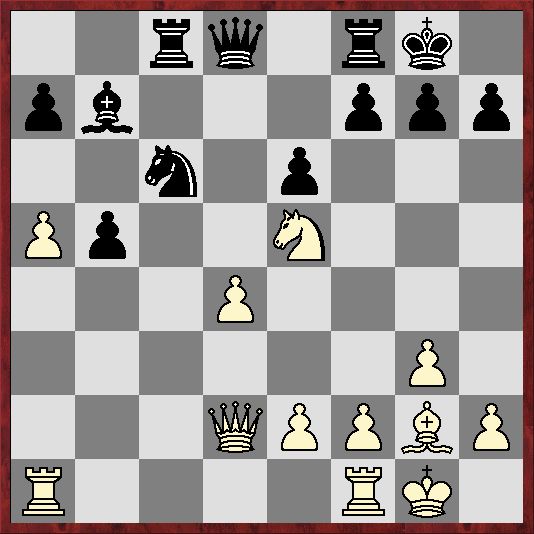
16.Qb2
It might be worth placing the pawn on a6 now that it had been moved: 16.a6 Ba8 17.Rfd1. Now it's not just a forced draw that is in Black's disposal, but something more ambitious.
16...a6 17.Nd3 Ba8!
Who said that the improved Tarrasch Defense is an opening to play for a draw? Kramnik rejects 17...Nxd4 18.Bxb7 Rc2 19.Qa3 Rc3 20.Qb2 Rc2 with equality and starts eyeing White pawns. There is no 18.e3 Nxa5, so Svidler gives away an important bishop, but his knight makes it to a support square.
18.Bxc6 Rxc6
18...Bxc6 19.Nc5 is worse.
19.Nb4
19.Nc5 is now followed by 19…e5.
19...Rc4!?
Black seeks to stir up trouble! He had the quiet 19...Rd6 20.e3 Qg5 in his disposal, aiming to throw his attack team upon the white king, but Kramnik forces complications: he gives away the a6 pawn and starts chasing the enemy knight.
20.Nxa6 Qd5 21.f3 Rxd4 22.Nc7 Qc5
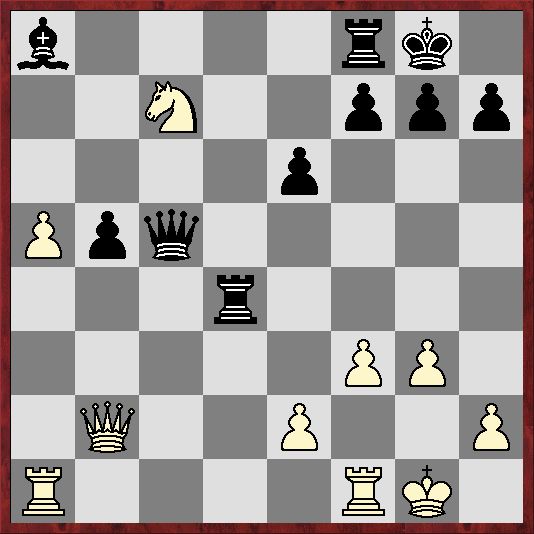
23.Kh1
Svidler hid his king further away from the place of the black rook's possible intrusion on the second rank, but in hindsight he should have played 23.Kg2!
23...Bc6 24.Rfc1 Rc4 25.Na6?
A mistake in a very complex position that put White in trouble at once.
The engine is not a human. It laughs at Black's threats and promotes the pawn to a queen, and all the lines end in a spectacular draw: 25.a6! Rc8 (the alternatives are 25...g5 26.Rxc4 bxc4 27.a7 g4 28.Qf6 c3 29.Na6 Qxa7 30.Qg5+ Kh8 31.Qf6+ or 25...Bxf3+ 26.exf3 Qxc7 27.Rxc4 Qxc4 28.a7 Qd5 29.Kg2 Ra8 30.Ra5 Qd7 31.Qxb5 Qd2+ 32.Kh3 Qh6+ 33.Kg2 Qd2+ with perpetual check) 26.Rxc4 bxc4 27.a7 c3 28.Qb8 Rf8 29.Na6 Qe3 30.Nb4 Bxf3+ 31.exf3 Qxf3+ 32.Kg1 Qe3+ 33.Kf1 Qf3+.
25...Qf2! 26.Qe5
Svidler laid hopes on the queen's retaliatory attack, but after the light-squared bishop's precise maneuver difficult times begin: the king is in trouble, as well as the knight that is cut off from the rest of the army.
26…Bd5!
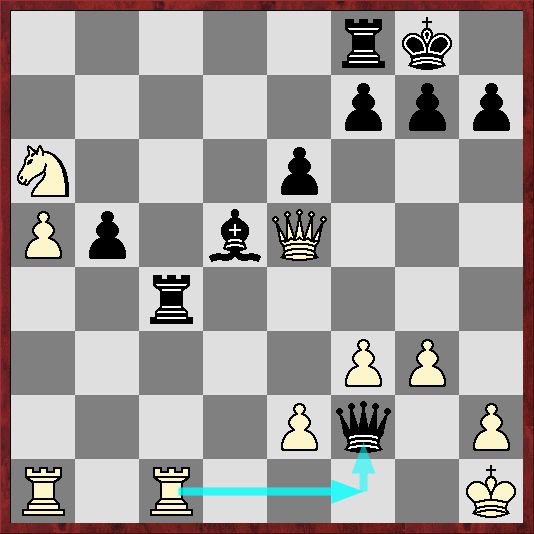
27.Nc7?
This already loses, but the St. Petersburg grandmaster might have disliked the strongest 27.Rf1 Qa7! 28.e4 Bxe4 29.fxe4 Qxa6, where White is a pawn down.
27...f6
27...Rxc1+ 28.Rxc1 Bc4! would have won immediately as the e2 square couldn't have been protected, but Kramnik's approach doesn't spoil anything either.
28.Qd6 Rxc7
The engine's first line, 28...Rxc1+ 29.Rxc1 Bxf3+ 30.exf3 Qxf3+ 31.Kg1 Qe3+ 32.Kg2 Qxc1 33.a6, looks unclear to a human: how do you fight the a6 pawn? Kramnik heads for an ending with two extra pawns, which is much more practical.
29.Qxc7
If 29.Rxc7 Qxe2 30.Rc3 Bxf3+ 31.Rxf3 Qxf3+ 32.Kg1 Qe3+ 33.Kh1 Qe4+ 34.Kg1 b4 35.a6 b3, an easily convertible endgame with four pawns versus two soon ensues. But everything was over much more quickly in the game.
29...Qxe2 30.Ra3, and Svidler resigned without waiting for 30...b4.
Thus, Siberia won 4-2, and now we are looking forward to its retaliatory match versus the Muscovites. By the way, I will add something to my previous note in the blog. I came across Sergei Rublevsky in an elevator after breakfast, and he gave me a crash course in the Najdorf Variation. 1.e4 c5 2.Nf3 d6 3.d4 cxd4 4.Nxd4 Nf6 5.Nc3 a6 6.Be3 Ng4 7.Bg5 h6 8.Bh4 g5 9.Bg3 Bg7 10.h3 Ne5 11.Nf5 Bxf5 12.exf5 Nbc6 13.Nd5 e6 14.fxe6 fxe6 15.Ne3 Qa5+ 16.c3 Nf3+ 17.Qxf3 Bxc3+ 18.Kd1 Qa4+ 19.Nc2 Bxb2 20.Rc1 Rc8!, which occurred in the Karjakin vs. Grischuk game, is a forced draw.
Which is why White has hardly ever been choosing this line with the knight on f5 of late. For some reason I thought I should write that Black's attempt didn't make the line more popular, but the morning blog says that "it wasn't successful". Well, words fly away and the written letter remains, but I hope Alexander doesn't have a grouch against me.
Day three
The tournament has gradually set into routine. Even the arbiter with the starting pistol, a good man with a refined sense of humor, got used to the pressure of this major event. Instead of the usual "Those who play Black start those who play White" he said today, "Those who play WHITE start THE CLOCK of those who play BLACK."
Everyone is playing in a good mood. In the Higher League, for example, an episode occurred during the round today that raised a storm of laughter. In a critical match Bulbozavry – SDYuSShOR ShSh (Chigorin's Club), that was to determine who would emerge as second after Malakhit, Khismatullin faced Alekseenko on board one. Denis played a cunning opening and, through an unusual move order, lured the Russian U-21 champion into the main and classical Catalan position.
Khismatullin (Bulbozavry) – Alekseenko (SDYuSShOR ShSh)
1.Nf3 d5 2.g3 Nf6 3.Bg2 e6 4.0–0 Be7 5.c4 0–0 6.d4 dxc4 7.Ne5
The move that Vladimir Kramnik brought back to life in elite chess. In order to set the c8 bishop free, Black is obliged to sacrifice a pawn: 7...Nc6 8.Bxc6 bxc6 9.Nxc6 Qe8 10.Nxe7+ Qxe7. And here Vladimir showed that if 11.Qc2 (Kramnik – Carlsen, 2011) or 11.Na3 (Kramnik – Anand, 2014, Kramnik – Adams, 2015), then it's not as simple as they thought back in the 20th century.
I suspect that Alekseenko didn't want to compete with his well-versed opponent in that line, so after some consideration he opted for a very rare line, 7...Qd6. It looks artificial, but there's an idea behind: placing the rook on d8 quickly. By the way, several opening gurus such as Vitaly Sivuk and the Spanish Olympian Salvador Gabriel Del Rio de Angelis have recently played it
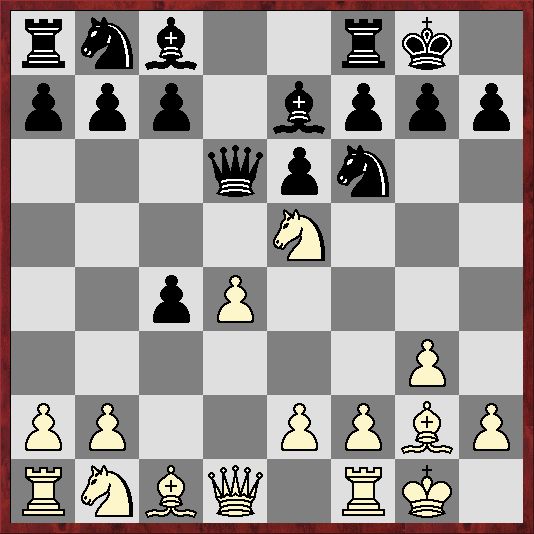
And then Yuri Meshkov, a well-known coach and organizer from Smolensk, approached the table. There was no limit to the surprise of Yuri, who brought a team of visually handicapped players that have been performing brillianty so far. Seeing the queen on d6, Meshkov began to study the board and then the score sheet through his strong spectacles. It seemed that the Soviet chess school disapproved of this queen push. It's hard for me to judge the move's objective strength, but it was Khismatullin who brought the point home in a complicated fight.
Denis Khismatullin vs. Kirill Alekseenko
Yuri Meshkov
Meanwhile, one of the tournament's most beautiful games was played in the Premier League. In a match against Kazan's Ladya (Rook), the Muscovites gave a day off to both of their leaders, Sergey Karjakin and Ian Nepomniachtchi. It seems that this would give practical chances to Gata Kamsky's team, but the Moscow players were again on the roll and won in all the three white games. The toughest battle occurred on board two: Vladislav Artemiev courageously chose the sharpest line of the Najdorf Variation versus Evgeniy Najer, but was unable to fend off his opponent's attack.
Vlad Artemiev and Gata Kamsky: time will come for Kazan to shine!
Najer (ShSM Legacy Square Capital) – Artemiev (Ladya)
Sicilian Defense
1.e4 c5 2.Nf3 d6 3.d4 cxd4 4.Nxd4 Nf6 5.Nc3 a6 6.Be3 Ng4 7.Bg5 h6 8.Bh4 g5 9.Bg3 Bg7 10.h3 Ne5
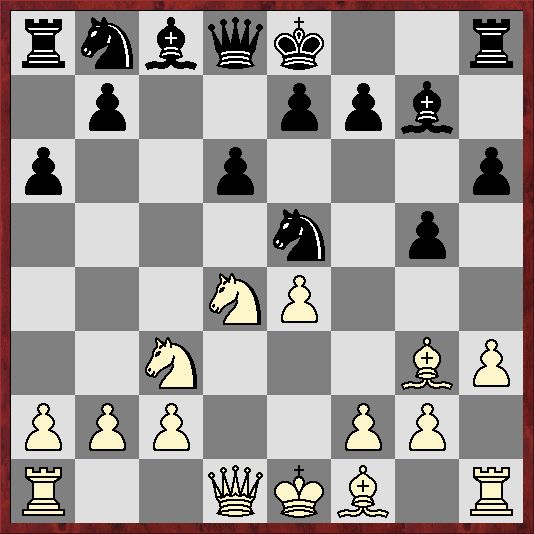
11.Nf5
The knight's leap to f5 has given way to the solid 11.f3 in recent years, and it seemed that the main battles in that line had been fought in the previous decades.
11…Bxf5 12.exf5 Nbd7
12...Nbc6 was flatly rejected after the Svidler vs. Grischuk game in Mexico: 13.Nd5 e6 14.fxe6 fxe6 15.Ne3 Qa5+ 16.c3 Nf3+ 17.Qxf3 Bxc3+ 18.Kd1 Qa4+ 19.Nc2 Bxb2 20.Rc1! – Alexander's next attempt to revive the line with 20…Rc8!? wasn't successful.
Which is why the knight is developed on d7 with the idea 13.Nd5 Nb6. But Najer suddenly went for the old games of grandmaster Goloshchapov performed in 2002...
13.Be2 Rc8 14.0–0 Nb6
Goloshchapov stormed Black's bastions after 14...0–0 15.h4, and in this light Vlad's response seems to be much more logical. And here after some subtle prophylaxis (which is also the engine's first line) Evgeniy went all out!
15.Rb1! 0–0 16.f4! Nec4 17.fxg5! Ne3 18.Qd3 Nxf1 19.gxh6 Bf6
19...Bxc3 20.bxc3 is very bad; Artemiev left the white pawn as a cover for his king. And the h6 pawn is the second pawn for an exchange anyway.
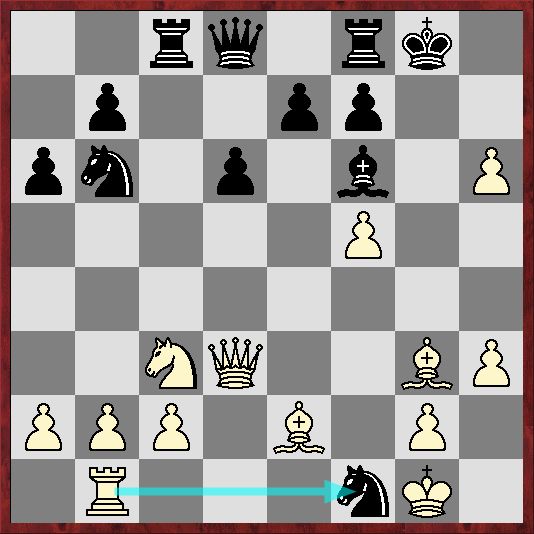
20.Rxf1 Kh7 21.Kh1 Qc7 22.Bf4 Qc4 23.g4 Rg8 24.Qg3!
The stupid ChessBomb and chess24 engines advised 24.g5 Bxg5 25.f6+ Qxd3 26.Bxd3+ Kxh6 27.fxe7, which is not so clear, and it is only at a great depth that a computer begins to realize what a strong player Evgeniy Najer really is.
24...Qb4
There were chances for defense after 24...Qc6+ 25.Bf3 d5, trying to engage the queen, but Black's position is still alarming. The attempt of intrusion on the queenside didn't save the Omsk player.
25.Bd3 Qxb2 26.Ne4 d5
After 26...Nd5 27.g5 White's attack seems to be overwhelming. Artemiev decides to give back the exchange, but Najer finds a pretty final combination in the endgame.
27.Nxf6+ exf6 28.g5 fxg5 29.f6+ Rg6
29...Kh8 30.h7! changes nothing.
30.Bxg6+ fxg6 31.Bxg5 Qxc2 32.Qe5 Qe4+ 33.Qxe4 dxe4 34.Rb1 Rc6
It's worth performing this on the board just for the sake of beauty!
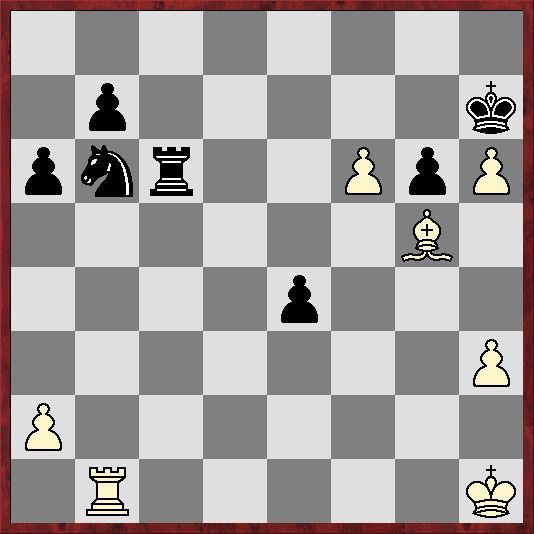
35.Rxb6! Rxb6 36.f7 Black resigned.
As popular wisdom holds, when Najer is on the roll, Maksim Notkin doesn't need to spend much time on choosing the "Game of the Month." This is where I would like to take leave before the crucial match Medny Vsadnik vs. Siberia. I'll just note that the photos in the blog were shot by Vladimir Barskij.
Day two
And lo – the plains then overflowed
With distant, bursting cries: hurrah!
The troops had caught a glimpse of Sergey.
He tore ahead of all the ranks,
Enraptured, mighty as the battle.
His eyes devoured the martial field.
Alexander Pushkin about the ShSM vs. Siberia match
(Paraphrasing Pushkin's famous poem Poltava as translated by Ivan Eubanks)
May's most dramatic event, the Russian Team Championship, continues in the Zhemchuzhina Grand Hotel. Before moving on to the central match, the battle between the Muscovites and the Siberians, we'll briefly pass by the Higher League and the Women's Championship.
In the second men's event, the leaders keep losing points. The team created in memory of Ivan Bukavshin was unable to defeat the resilient Avtomatika despite another masterpiece by Denis Khismatullin. The brave team of visually handicapped players keeps fighting on a par versus the powerful Chigorin Club: 2-2. The leaders are the Moscow Region, which defeated the players from Grozny (3-1), and Malakhit, which routed Yamal (3.5-0.5). The victory of the Yekaterinburg team's captain set the tone in the match between the two teams that played in the Premier League last year.
Shariyazdanov (Malachite) – Sergeyev (Yamal)
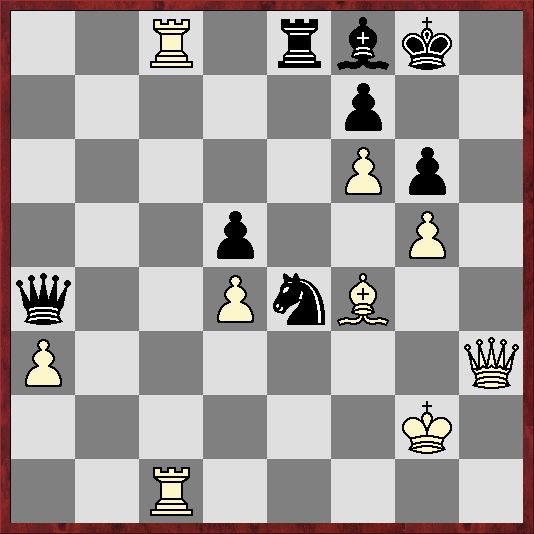
Black is an exchange down, but it is easy to see that his king has no moves, and Alexander Sergeyev sets a tricky trap.
44...Nd2!? 45.Bxd2 Re2+ 46.Kf1 Re1+ 47.Rxe1 Qa6+
It turns out that 48.Kf2 Qe2+ leads to a stalemate! It's easy to respond 48.Kg1 with the idea 48…Qf1+ 49.Qxf1, but to be on the safe side Andrey Shariyazdanov played
48.Rc4 Qxc4+ 49.Kg2 Qxd4 50.Re2 and ensured an overall win in the match for his team.
By the way, your author learned an interesting story about the Bulbozavry team. You already know from Vladimir Barsky's report why Khismatullin's club has such a name, and here's a story about how this might have prevented one of the players from joining a tournament. One of the Bulbozavry players flew to Sochi via Turkey coming back from another tournament. As you know, Russia and Turkey are not getting along very well now. And he was a young and sturdy guy. The Russian airport's security officers took alarm: what if he is a Turkish secret agent or, worse, has been hired by the Islamic State that is banned in Russia?
They called a security expert and interrogated the player for 40 minutes. The specialist, of course, could quickly tell a chess player from a terrorist, but he still asked a final question: "What team are you going to play for in Sochi?" And the Bulbozavry player realized that he was trapped: if he mentioned such a funny name, all would be lost. Security officers don't like joking. So he had to give the name of his team's main rivals, the Malakhit Club. This version fully satisfied the interrogator. A solid name is the key!
In the women's championship, Moscow defeated St. Petersburg with a minimal score thanks to a quick win by Alina Kashlinskaya, while the other three matches ended in a draw, which is a very rare thing for ladies' competitions. Polina Shuvalova saved the Yunost Moskvy vs. Kazan match by defeating Alisa Galliamova, Bukavushki had a draw with Donchanka, and Yugra and Boavishta had a 2-2 score, although the Muscovites were really lucky here.
Kovanova (Ugra) – Vasilevich (Boavishta)
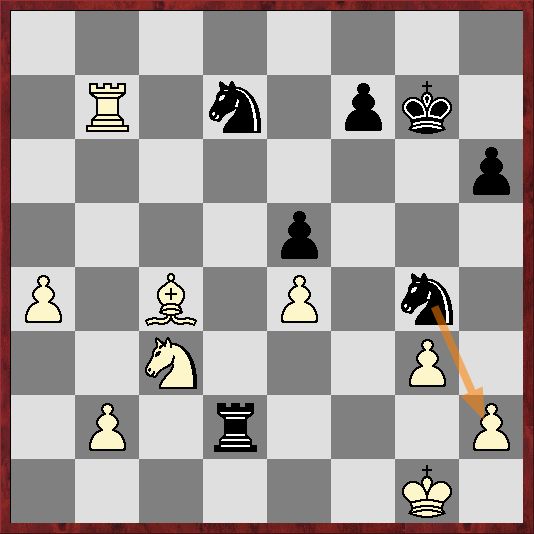
The courageous Irina Vasilevich came to play a month before the birth of her baby, and the generous Baira Kovanova took mercy and missed an opportunity to win.
31.Bd5?
The winning options were 31.a5! Nxh2 32.Be2 or 31.Be2.
31...Nxh2 32.Rxd7?
Vasilevich saw at the board 32.Ne2! Nf3+ (32...Rxe2 33.Rxd7 Rxb2 34.Rxf7+) 33.Kf2 Nd4 34.Rxd7 Rxe2+ 35.Kf1 Rxb2 36.Rxf7+ Kg6 37.Rb7 with a decisive advantage for White.
32...Nf3+ 33.Kf1 Nh2+ 34.Ke1 Nf3+ Draw.
Let's move on to the Premier League now. The Siberians optimistically came to the match without Vladimir Kramnik, who is taking a rest after his joint press conference with Veselin Topalov in Stavanger. The Euro Cup owners had a hard time in this match. The Muscovites, inspired by the arrival of the suntanned and well-rested Karjakin, surged forward from the first minutes of the match. Alexander Grischuk held Sergei at bay, but Siberia's middle boards were unable to bear the strain and suddenly crumbled.
Inarkiev (ShSM Legacy Square Capital) – Jakovenko (Siberia)
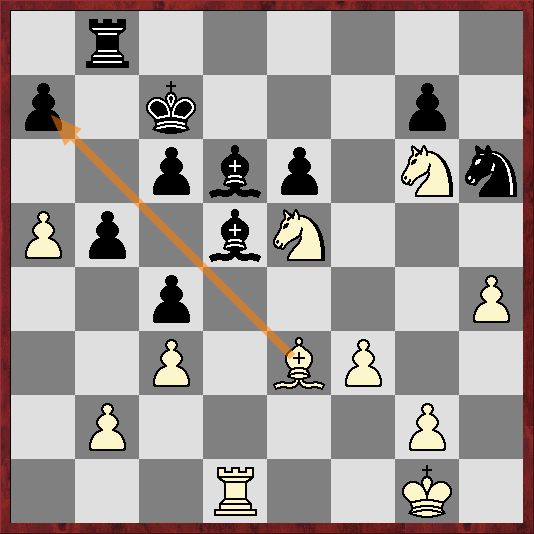
White holds the initiative in a Berlin endgame, but 29...c5 doesn't seem to lose anything directly. Dmitry Jakovenko probably decided to "spice up" the game a little, but miscalculated a line.
29...b4? 30.Bxa7 Rb5 31.Bb6+ Kb7
In the event of the immediate 32.Rd2 bxc3 33.bxc3 Nf5 with a subsequent Rb3, Jakovenko's idea would have worked perfectly well, but a simple 32.Nxc4! Nf5 34.Nxd6+ Nxd6 35.cxb4 Nc4 was found.
A third pawn perishes now in view of 35...Rxb4 36.Bc5
36.Bd4 Rxb4 37.Bxg7 Ne3 38.Rd2 Ra4 39.b3 Rxa5 40.h5 Black resigned.
Rublevsky (Siberia) – Zvjaginsev (ShSM Legacy Square Capital)
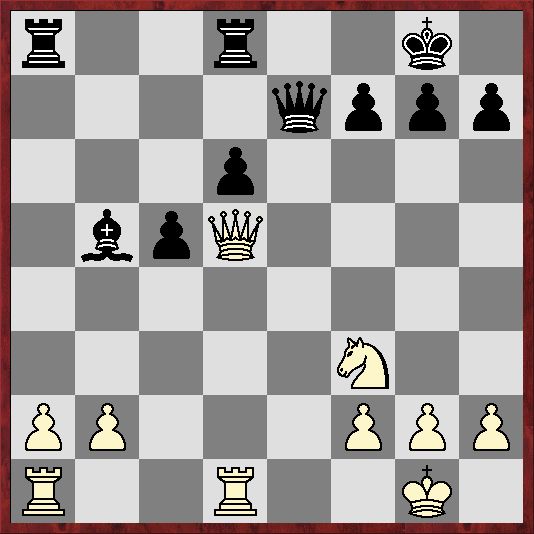
21.Nd4 led to a draw, but this simple move was suddenly overlooked by the senior coach of the Russian women's team.
21.h3?! Qe6! 22.Qxe6 fxe6, and Vadim converted this ending, where Black is better, perfectly well.
Dubov (ShSM Legacy Square Capital) – Korobov (Siberia)
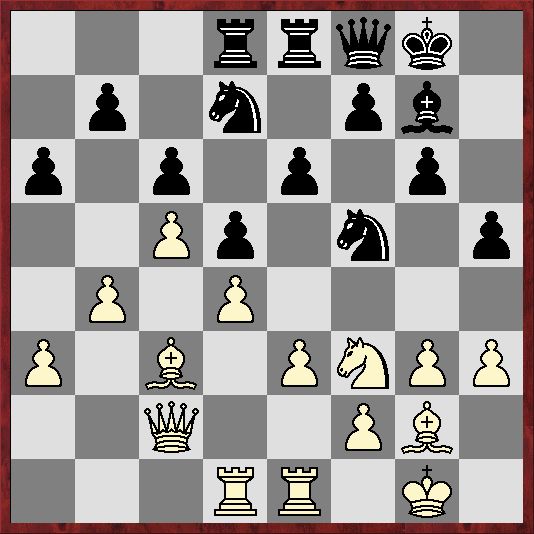
Daniil gave his opponent serious problems, and Anton's attempt to break free immediately led to a disaster.
22...e5? 23.dxe5 Nxe5 24.Bxe5! Rxe5
It turns out that after 24...Bxe5 there's the killing blow 25.e4! Korobov decided to give away an exchange
25.Nxe5 Bxe5 26.e4 Nd4 27.Qb1 dxe4 28.Qxe4 Bf6 29.h4 Kg7 30.Bf1 a5 31.Kg2 axb4 32.axb4 Rd5 33.Bc4, and was unable to save the game.
A crushing defeat of the world's strongest club with the score 4.5-1.5! As the saddened Pavel Maletin and Vladimir Vorozheikin were leaving the battlefield, a colleague of mine uttered behind my back, imitating the sonorous voice of Zeus, "It's time to release the Kraken!"
Day one
Good morning, dear chess lovers! This is Dmitry Kryakvin, and on my blog I will share with you my impressions of the epic event that has kicked off in Southern Russia. The Russian Club Championship is taking place at Zhemchuzhina, not only a fabulous hotel, but a hotel with incredible chess history. Mikhail Tal, Boris Spassky, Lev Polugaevsky and other great players once walked along the place where I am now sitting and writing these lines. It happened during the legendary Chigorin Memorials organized in Sochi by a team headed by Yuri Lobanov and Vera Tikhomirova. Modern stars have replaced titans of the past, and it's great that the Russian Chess Federation and the club league have thus revived a tradition lost for 25 (just think of it!) years. 25 years! It's longer than dear Ivan Bukavshin lived. The players honored his memory at the opening ceremony.
It so happened that at this tournament your humble servant represents both the Malakhit club, which is one of the favorites of the Championship's Higher League, and the Russian Chess Federation's website. Which is why I have a challenging task: to please my readers and at the same time do my best for Nukhim Rashkovsky's team. As a result, it was decided during a secret meeting of the website's staff to follow the practice of 2012, resuming the blog format. It's not too energy consuming and I can use it to share something of interest that was missed in the reports. My colleague Vladimir Barsky and I will try not to repeat each other. If the blog's main page has changed its title and image, an update is ready for you!
The author and his teammate Sergey Volkov
The tournament proves to be very interesting. Of course, there are only five teams in the Premier League, but look at the Higher League and the Women's Championship: they are by far stronger than last year. Those are mighty teams consisting of young and ambitious players under supervision of seasoned professionals. And it goes without saying that the women are also very strong: we only have to wait for Alexandra Kosteniuk to come from a FIDE Grand Prix stage. To recap, it was won by Valentina Gunina, while the world ex-champion is fighting for second place.
The strongest men's teams have also given us a pleasant surprise: it turns out that none other than Sergey Karjakin, the challenger for the world championship, has joined the ranks of ShSM Legacy Square Capital (three English words in the name, although we are playing a Russian championship). The entire Sochi will probably gather to look at his battles with Vladimir Kramnik, but for now the Moscow team's captain has had to decide who will be deleted from the list: one can't leave nine players there since only eight are permitted. The "black mark" was awarded to Boris Grachev, but according to the rumors that shouldn't be reported to the tax office, Boris also received a box of jewels. He took it and departed for Moscow to watch his team's play online.
And indeed there was something to watch! While the powerful Siberia, even without Kramnik, routed Kazan's Ladya 5-1, a real carnage unleashed in the match of the two Russian capitals. The tone was set by Ernesto Inarkiev, who faced Leinier Dominguez. The Cuban grandmaster is an elite and resilient player, a real pillar on Vladimir Bykov's team. But that Sochi evening he failed to resist Ernesto, who burst into action.
Inarkiev (ShSM Legacy Square Capital) – Dominguez (Bronze Horseman)
1.d4 Nf6 2.c4 g6 3.Nc3 d5 4.Bf4 Bg7 5.e3 0–0 6.Rc1 Be6 7.c5 Nh5 8.Bg5 h6 9.Bh4 b6 10.b4 a5 11.b5 bxc5 12.dxc5 Nd7 13.Na4 Ne5 14.Ne2 Bg4 15.Qb3 g5 16.Bg3 Ng6 17.Rd1 e5 18.Rxd5 Qe7 19.Nec3 Ngf4 20.Rd2 Rad8 21.f3 Be6 22.Qc2
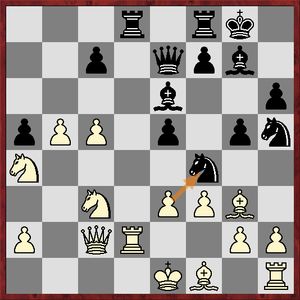
A men's duel in the Grünfeld Defense led to a position on the diagram that invites you to play in Garry Kasparov's spirit, particularly after the recent blitz tournament: 22...Rxd2! 23.Qxd2 Rd8 24.Qc2 e4!! 25.fxe4 (25.exf4 gxf4 26.Bf2 e3 is bad) 25...Nxg3 26.hxg3 Ng6 with a great compensation for the lost pawns. Dominguez lingered, however, and Inarkiev blocked the pride of Black's position. It would have to sit on g7 and wait.
22…Nf6 23.e4! g4 24.Bf2 Nh7 25.fxg4 Bxg4 26.Be3 Qg5 27.Nd5 Nf6 28.Nac3 Be6
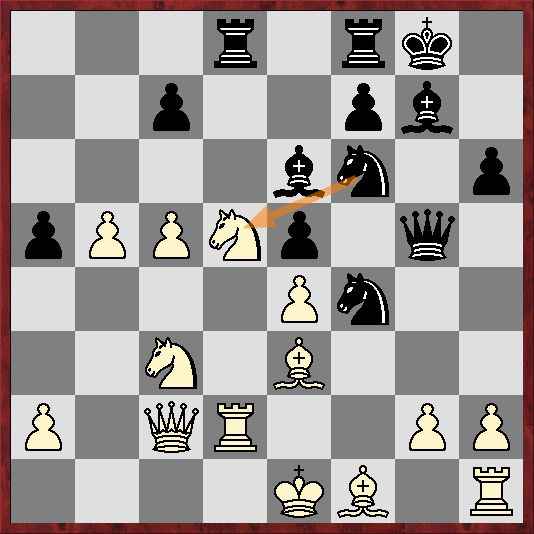
Curiously, the engine suggests the following line: 29.h4!! Qg4 30.Nxc7! Rd4! 31.Rf2!! promising an advantage of more than two pawns. It's clear that the players are humans, not machines, and Ernesto chose the most humanly accurate solution that forced simplifications. Just what you need if you have an edge!
29.g3!? Bxd5 30.Nxd5 N6xd5 31.exd5 Ng2+
A sharper line fails as well: 31...Qh5 32.gxf4 Qf3 33.Qd3 Qxh1 34.Rg2, and the queen is trapped.
32.Bxg2 Qxe3+ 33.Kd1
33.Re2 Qd4 is inaccurate. White's king has an excellent location on d1, and his pawns will promote faster.
33...f5 34.Re1 Qa3
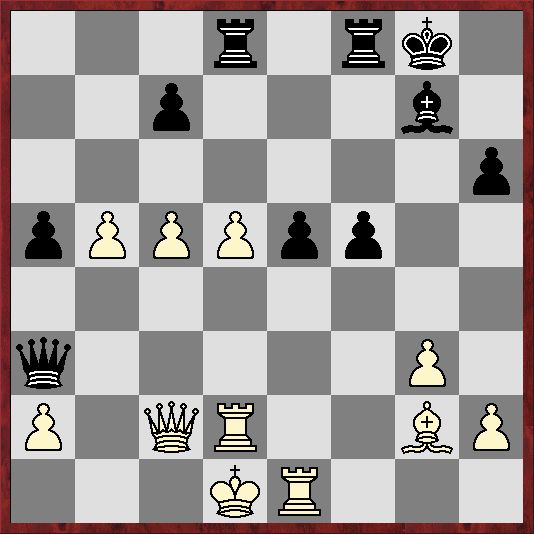
35.d6! e4
35...cxd6 36.c6 is hopeless.
36.Qb3+! Qxb3+ 37.axb3 Bc3 38.Rc2 Bxe1 39.Kxe1 Rd7
Winning the exchange after trading off the queens didn't make Black's life easier. He has no means to stop the white connected passers: 39...Rb8 40.Bf1.
40.Bf1 cxd6
40...Rb8 is more robust, but it doesn't save the day: 41.dxc7 Rxc7 42.b6 Rc6 (42...Rxb6 43.cxb6 Rxc2 44.b7) 43.Bb5 Rcc8 44.Bd7 – it's easy as pie for Inarkiev.
41.c6 Black resigned. An impressive victory!
Nikita Vitiugov settled the score for St. Petersburg after converting skillfully an extra pawn that he had won in complications versus Evgeniy Najer. Vadim Zvjaginsev won a pawn facing Bu Xiangzhi, but they had opposite-colored bishops with few material on the board... The final score of the match is 3-3!
There was much more intrigue and sensations in the Higher League. Amazingly, almost all the matches were very tense there. Malakhit claimed a hard-fought victory over Kamchatka thanks to Sergey Volkov's arduous win, and the strong Petrovskaya Ladya had to content itself with a draw against the legionnaire-free Politekhnik. And that's not all! A team of visually handicapped players defeated the Moscow champions – the team of Sergey Arkhipov and his students. Moreover, in the leaders' game Daria Pustovoitova knocked out Urii Eliseev.
The team set up in memory of Ivan Bukavshin had a hard-earned victory too: with the score 1.5-1.5, Denis Khismatullin had his weighty say.
Khismatullin (Bulbozavry) – Sergei Chekhov (Voronezh)
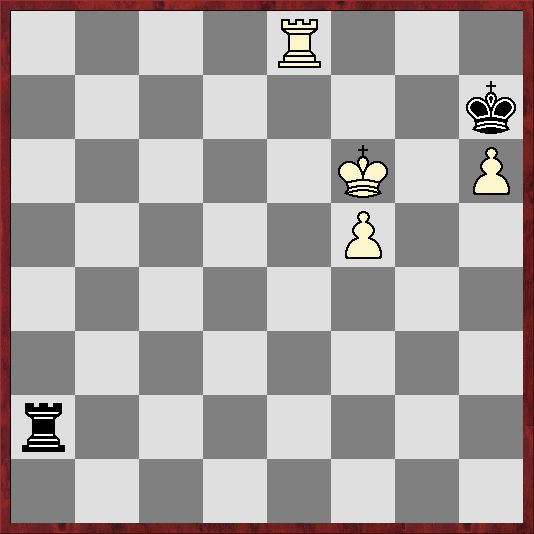
The master from Voronezh fought ingeniously against the famous grandmaster and almost reached a draw. But Denis demonstrated extraordinary technique in the well-known Botvinnik-Keres-Grischuk endgame (those three players made a great contribution to its theory) with the f and h pawns and was able to break his young opponent's resistance.
75...Ra6+?
The first and decisive mistake! If the white king penetrates on f6, Black can only be saved with a precise sequence of moves: 75...Ra1 76.Kf7 Kxh6! 77.f6 Ra6! 78.Re1 (or 78.Rh8+ Kg5)78...Ra7+ 79.Re7 Ra6 80.Re6 Ra8!, and White can't strengthen its position, while in other cases the standard rule "king on the short side, rook on the long side" saves the day.
76.Re6 Ra1 77.Kf7 Ra5 78.f6
Black's loss of tempo resulted in the white king's intrusion to the eighth rank in the event of the h6 pawn's demise.
78…Ra7+ 79.Kf8 Kxh6 80.Re7 Ra8+ 81.Re8 Ra7 82.f7 Kg6 83.Re6+ Kh7 84.Re1 Ra8+, and the game was over according to the well-known patterns: 85.Ke7 Ra7+ 86.Kf6 Ra6+ 87.Re6 Ra8 88.Re8 Ra6+ 89.Ke5 Black resigned.
Bulbozavry and Voronezh
This is not Caruana and the Philidor position. In the Russian League, players perform classical endgames for the stronger side with clockwork precision!
The women's tournament lacked no great sensations either. Donchanka confidently outplayed St. Petersburg's ShSh SDYuSShOR with a 3-1 score. The other favorites gained the upper hand with ease as well, whereas the Muscovites had to sweat to win: their leader was defeated by Aleksandra Goryachkina, who went berserk after the tournament in Loo.
The capital versus the Southern superclub
Lagno (ShSM Legacy Square Capital) – Goryachkina (University)
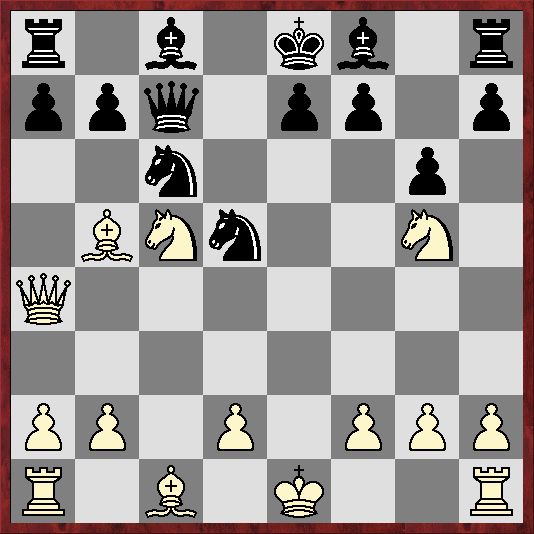
12.0–0
Goryachkina had just had a very hard time playing in an extremely strong U-21 tournament. Perhaps Kateryna's musketeer play was caused just by that. But Aleksandra countered her opponent's assault with great precision, and to get a good position Lagno had to find a simply fantastic dance of the queen.
Here it is: 12.Qd4! Nf6 13.Qc4! e6 14.Qc3! Be7 15.Nge4 e5 16.Bxc6+ bxc6 17.Nxf6+ Bxf6 18.d3 with all the three outcomes possible. This is crazy, have you ever seen such a thing? The Muscovite preferred to win the pawns, but lagged behind in development greatly.
12...Bg7 13.Bc4 Qd8 14.Nxb7 Bxb7 15.Qb5 0–0 16.Qxb7 Ndb4 17.Qb5 Rb8 18.Qa4 Ne5 19.Be2
White should have returned the booty urgently: 19.d3 h6 20.Ne4, because once the blocking knight sets foot on d3, White's forces are locked in sheds.
19...Ned3 20.Nf3
20.Qxa7 Nc2 21.Rb1 Qd5 22.Nf3 Nd4 23.Bxd3 Nxf3+ 24.gxf3 Qxd3 doesn't help.
20...e5
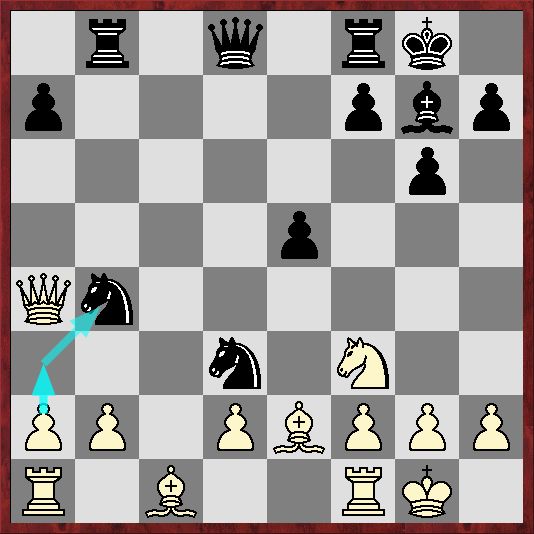
21.a3 Nf4! 22.Bd1 Nbd3 23.g3
Sparks of tactics are already visible everywhere: 23.Ne1 Qg5 24.g3 Nh3+ 25.Kg2 Nhxf2!
23...Nc5 24.Qc4 Nfd3 25.Bc2
25.Ne1 might have been tougher, but White's position is not to be envied.
25...e4! 26.Bxd3 Nxd3 27.Qxe4 Re8 28.Qa4
28.Qg4 Rc8 is formally better, but this would have hardly changed the outcome of the game.
28...Qd5 29.Nh4 Nxf2! White resigned.
What willpower this girl from Salekhard has! After the event in Loo, another person would have avoided chess for half a year, and she still plays and wins such games versus world-class opponents!
Yet Moscow retorted with Savina's and Kashlinskaya's wins that brought two points for ShSM.
Thus the start proved to be really captivating!












